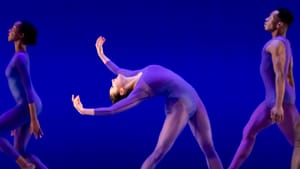Stay in the Loop
BSR publishes on a weekly schedule, with an email newsletter every Wednesday and Thursday morning. There’s no paywall, and subscribing is always free.
Great ballet meets live music at the Mann
BalletX presents its 2024 Spring Festival

There was a chill in the air on Friday, April 26, as we gathered at the Mann for BalletX’s 2024 Spring Festival, and a sign on the merch table offered blankets for sale. But that didn’t stop festivalgoers from taking in the community performances that filled the grounds before the main event. Under the roof at the TD Pavilion, we forgot the weather, caught up in the dancing. BalletX always puts on a great show, but the live music unique to each piece made this evening a standout.
Eros & Psyche
Choreographer Jamar Roberts flipped the script on his Eros & Psyche. In the ballet, set to Philip Glass’s Etude No. 8 and his piano quintet “Annunciation” Part 1, Eros was a woman and the arbiter of love and emotion, while a manly Psyche represented the realm of the physical. We are used to Glass’s driving complex beat, but the ensemble132 quintet gave us a dreamier side of his music. The dancing was marked by lightness and fluidity, punctuated with skipping steps and moments of bravado—Peter Weil’s Psyche with his chest outthrust and thumbs tucked into metaphoric suspenders—while Ashley Simpson was a dream of flexibility, with a touch of mime for a beating heart. The live music carried us along, adrift on the dreaming heart of the piece.
Heroes and duos
I loved Eros & Psyche for its fluid dancing and otherworldliness, but choreographer Takehiro Ueyama’s Heroes gripped us with the riveting story of a resurgent Japan after World War II. The piece honors the struggle of Ueyama’s parents’ generation to rebuild Japan from rubble into an economic powerhouse.
Heroes opened on a mostly darkened stage, with Jerard Palazo and Francesca Forcella in costume designer Eugenia P. Stallings’s red hakama pants and tops. They rested their heads on each other’s shoulders, and circled each other, foreheads touching, before opening up the dance with wide, deep knees, one leg stretched behind, reminiscent of Japanese martial arts. He lifted her on his shoulders, and at last, the couple stood facing each other and covered their faces in sorrow before donning tailored blazers in the same red color. He shifted the jacket off her shoulder and she put it back. There was no denying the future.

The duet was profoundly moving—you can always count on Forcella for deep emotion, and Palazo matched her; in their dance, we felt their love for each other, and their sorrow at the passing of a way of life. The new world entered with the 10 remaining dancers, who stepped onto a row of chairs, each with an arm raised as if grasping the strap on a subway car. Later the chairs were more scattered, and Itzkan Barbosa, her hair flying, dashed across them to leap madly into the arms of a waiting dancer—again, and again—as if trying to escape. The piece had so many striking moments, including the dancers marking the ticking of a clock with their arms rocking low in front of them. But the most powerful was the simplest, when the dancers faced the audience, one hand over their hearts, and the other on the shoulder of the person next to them in support and solidarity. It ended on Skyler Lubin, alone on the subway, with her arm still raised.
In a film before the performance, Ueyama said that he was inspired by Merce Cunningham’s collaborations with John Cage and Googled to find a Japanese composer in New York to collaborate on the piece. It was a fruitful search—Kato Hideki’s soundscape reminded us, with the harsh sounds of modernity, of the cost of the lost culture.
Got Soul
Choreographer Natasha Adorlee said that her piece reflected on how the struggles of the past remain with us today, and Got Soul featured the music of the 1960s and 1970s, with a live performance by the fabulous Jac Ross singing the works of great soul performers like Sam Cooke and Bill Withers. But Christine Darch’s costumes (capris and 1950s dresses for the women and pants and shirts for the men in an array of colors) seemed more like a dance party than a struggle, and the movement had a jazzy, social-dance feel to it as well.

The duets were wonderful, though. I cannot say enough about Simpson, whose fluid movement was so seamlessly woven throughout the dance, and Forcella twisted sinuously around partner Jared Kelly. Artistic director Christine Cox has said that she wants to reclaim the elevated space for modern ballet, and both duets gave us overhead lifts that expanded the dance to those heights. As a way to party out the door, the piece worked well, but I am not sure about the struggle.
What, When, Where
BalletX Spring Festival. Choreography by Natasha Adorlee (music by Jac Ross), Takehiro Ueyama (music by Kato Hideki), and Jamar Roberts (Philip Glass score performed live by ensemble132). BalletX. $25-$60. April 26-27, 2024, at the Mann Center for the Performing Arts, 5201 Parkside Avenue, Philadelphia. (215) 225-5389 or balletx.org.
Accessibility
For the Mann's accessibility details, please visit its website.
Sign up for our newsletter
All of the week's new articles, all in one place. Sign up for the free weekly BSR newsletters, and don't miss a conversation.
 Camille Bacon-Smith
Camille Bacon-Smith